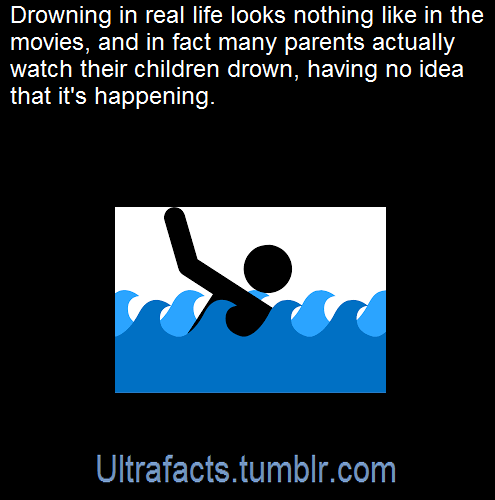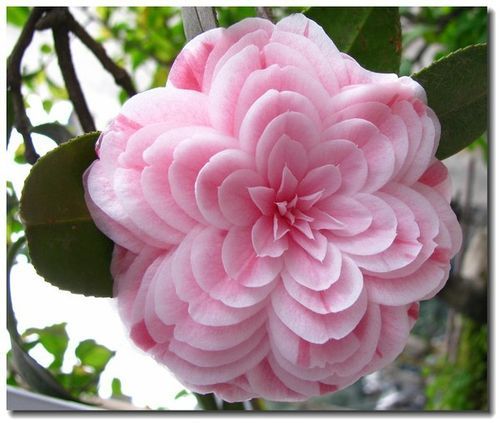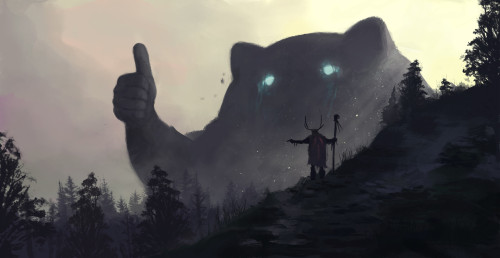Follow Ultrafacts For More Facts!

According to the CDC, in 10 percent of those drownings, the adult will actually watch the child do it, having no idea it is happening. Drowning does not look like drowning—Dr. Pia, in an article in the Coast Guard’s On Scene magazine, described the Instinctive Drowning Response like this:
“Except in rare circumstances, drowning people are physiologically unable to call out for help. The respiratory system was designed for breathing. Speech is the secondary or overlaid function. Breathing must be fulfilled before speech occurs.
Drowning people’s mouths alternately sink below and reappear above the surface of the water. The mouths of drowning people are not above the surface of the water long enough for them to exhale, inhale, and call out for help. When the drowning people’s mouths are above the surface, they exhale and inhale quickly as their mouths start to sink below the surface of the water.
Drowning people cannot wave for help. Nature instinctively forces them to extend their arms laterally and press down on the water’s surface. Pressing down on the surface of the water permits drowning people to leverage their bodies so they can lift their mouths out of the water to breathe.
Throughout the Instinctive Drowning Response, drowning people cannot voluntarily control their arm movements. Physiologically, drowning people who are struggling on the surface of the water cannot stop drowning and perform voluntary movements such as waving for help, moving toward a rescuer, or reaching out for a piece of rescue equipment.
From beginning to end of the Instinctive Drowning Response people’s bodies remain upright in the water, with no evidence of a supporting kick. Unless rescued by a trained lifeguard, these drowning people can only struggle on the surface of the water from 20 to 60 seconds before submersion occurs.”
This doesn’t mean that a person that is yelling for help and thrashing isn’t in real trouble—they are experiencing aquatic distress. Not always present before the Instinctive Drowning Response, aquatic distress doesn’t last long—but unlike true drowning, these victims can still assist in their own rescue. They can grab lifelines, throw rings, etc.
Look for these other signs of drowning when persons are in the water:
Head low in the water, mouth at water level
Head tilted back with mouth open
Eyes glassy and empty, unable to focus
Eyes closed
Hair over forehead or eyes
Not using legs—vertical
Hyperventilating or gasping
Trying to swim in a particular direction but not making headway
Trying to roll over on the back
Appear to be climbing an invisible ladder
So if a crew member falls overboard and everything looks OK—don’t be too sure. Sometimes the most common indication that someone is drowning is that they don’t look like they’re drowning. They may just look like they are treading water and looking up at the deck. One way to be sure? Ask them, “Are you all right?” If they can answer at all—they probably are. If they return a blank stare, you may have less than 30 seconds to get to them. And parents—children playing in the water make noise. When they get quiet, you get to them and find out why.
Source/article: [x]
Follow Ultrafacts for more facts!
More Posts from Alianora-of-toure-on-marsh and Others
terrifying monstrosity: who could possibly love me when I am a terrifying monstrosity me, stretched out on the table in front of them with a rose between my teeth: well
im putting together a couple of scottish folk mixes bc that’s what i do and im honestly curious if anyone in my country has ever been unequivocally happy about anything ever

reunited with Macayo, one of my oldest and wisest friends. he says 2018 is going to be a perfect year and that my hair still smells like crayons. (p.s macaws can live to be 90! that’s straight up the same bird in both pics. whaaaaat?)
Whats up with Hei Hei in some of the Moana promo art and posters? Like


And like


And even????

He’s so angry and ready to Throw Down
But then in actuality he’s just

Disney explain


Speaking of pretty flowers, may I present to you the “Eighteen Scholars”, the flower of my heart-a variation of Camellia japonica L. Its uniqueness lies in the layers and layers of petals-one flower can hold as much as 130 petals.
Named “Eighteen Scholars” in Chinese because at the most, one bush can have up to eighteen of these pretty darlings :3
-
 duelfeather-art liked this · 1 month ago
duelfeather-art liked this · 1 month ago -
 76ello reblogged this · 1 month ago
76ello reblogged this · 1 month ago -
 polkadot-creeper liked this · 1 month ago
polkadot-creeper liked this · 1 month ago -
 desfraisespartout reblogged this · 1 month ago
desfraisespartout reblogged this · 1 month ago -
 dragonfly-general reblogged this · 1 month ago
dragonfly-general reblogged this · 1 month ago -
 marlovestrees reblogged this · 1 month ago
marlovestrees reblogged this · 1 month ago -
 whisperingballoon liked this · 2 months ago
whisperingballoon liked this · 2 months ago -
 whisperingballoon reblogged this · 2 months ago
whisperingballoon reblogged this · 2 months ago -
 whorechatas reblogged this · 2 months ago
whorechatas reblogged this · 2 months ago -
 spookysshadow reblogged this · 2 months ago
spookysshadow reblogged this · 2 months ago -
 blueberrypuffins liked this · 2 months ago
blueberrypuffins liked this · 2 months ago -
 texasturtlefan reblogged this · 3 months ago
texasturtlefan reblogged this · 3 months ago -
 heckcareoxytwit liked this · 5 months ago
heckcareoxytwit liked this · 5 months ago -
 annaiw106 liked this · 5 months ago
annaiw106 liked this · 5 months ago -
 annao81ly liked this · 6 months ago
annao81ly liked this · 6 months ago -
 notgonnapost4 reblogged this · 6 months ago
notgonnapost4 reblogged this · 6 months ago -
 notgonnapost4 liked this · 6 months ago
notgonnapost4 liked this · 6 months ago -
 21kln647xpyih5ewgqgslvvfa reblogged this · 6 months ago
21kln647xpyih5ewgqgslvvfa reblogged this · 6 months ago -
 21kln647xpyih5ewgqgslvvfa liked this · 7 months ago
21kln647xpyih5ewgqgslvvfa liked this · 7 months ago -
 violatime reblogged this · 7 months ago
violatime reblogged this · 7 months ago -
 violatime liked this · 7 months ago
violatime liked this · 7 months ago -
 modularnra40 reblogged this · 7 months ago
modularnra40 reblogged this · 7 months ago -
 modularnra40 liked this · 7 months ago
modularnra40 liked this · 7 months ago -
 marlovestrees reblogged this · 7 months ago
marlovestrees reblogged this · 7 months ago -
 itsmedontpanic liked this · 7 months ago
itsmedontpanic liked this · 7 months ago -
 wrongfulnoodle3120 reblogged this · 7 months ago
wrongfulnoodle3120 reblogged this · 7 months ago -
 wrongfulnoodle3120 liked this · 7 months ago
wrongfulnoodle3120 liked this · 7 months ago -
 roboremy liked this · 7 months ago
roboremy liked this · 7 months ago -
 nyrithsamandri reblogged this · 7 months ago
nyrithsamandri reblogged this · 7 months ago -
 nyrithsamandri liked this · 7 months ago
nyrithsamandri liked this · 7 months ago -
 rainbowdelicsunshine reblogged this · 7 months ago
rainbowdelicsunshine reblogged this · 7 months ago -
 rainbowdelicartz liked this · 7 months ago
rainbowdelicartz liked this · 7 months ago -
 thetideizhigh reblogged this · 7 months ago
thetideizhigh reblogged this · 7 months ago -
 sanctuaryforalluniverses reblogged this · 7 months ago
sanctuaryforalluniverses reblogged this · 7 months ago -
 felren13 reblogged this · 7 months ago
felren13 reblogged this · 7 months ago -
 the-tomorrow-road reblogged this · 8 months ago
the-tomorrow-road reblogged this · 8 months ago -
 the-tomorrow-road liked this · 8 months ago
the-tomorrow-road liked this · 8 months ago -
 aeshnacyanea2000 reblogged this · 8 months ago
aeshnacyanea2000 reblogged this · 8 months ago -
 waitingforanonshittydayinhell reblogged this · 8 months ago
waitingforanonshittydayinhell reblogged this · 8 months ago -
 thisiswhereilearntolovemyself liked this · 8 months ago
thisiswhereilearntolovemyself liked this · 8 months ago -
 bastard-sweet reblogged this · 8 months ago
bastard-sweet reblogged this · 8 months ago -
 mommawitchbitxh reblogged this · 8 months ago
mommawitchbitxh reblogged this · 8 months ago -
 unscrupuloussnook reblogged this · 9 months ago
unscrupuloussnook reblogged this · 9 months ago -
 endless-x-summers reblogged this · 9 months ago
endless-x-summers reblogged this · 9 months ago -
 plonk-bing liked this · 9 months ago
plonk-bing liked this · 9 months ago -
 fantasticblazepoetry reblogged this · 9 months ago
fantasticblazepoetry reblogged this · 9 months ago -
 annoyingdelusioncreation liked this · 10 months ago
annoyingdelusioncreation liked this · 10 months ago
193 posts







